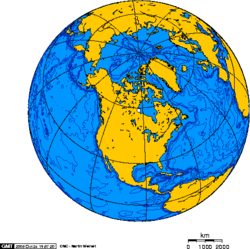| This page is currently inactive and is retained for historical reference. Either the page is no longer relevant or consensus on its purpose has become unclear. To revive discussion, seek broader input via a forum such as the village pump. |
Geography of North America North America is the third largest continent, or a portion of the second largest if North and South America are combined into the Americas and Africa, Europe and Asia are considered to be part of one supercontinent called Afro-Eurasia. With an estimated population of 460 million and an area of 24,346,000 km² (9,400,000 mi²), the northernmost of the two continents of the Western Hemisphere is bounded by the Pacific Ocean on the west; the Atlantic Ocean on the east; the Caribbean Sea, Atlantic and Pacific oceans, and South America on the south; and the Arctic Ocean on the north. Canada covers most of the northern half of North America, much of which is sparsely populated, except for the northwestern portion which is occupied by Alaska, the largest state of the U.S. The central and southern portions of the continent are represented by the United States, Mexico, and numerous smaller states primarily in Central America and in the Caribbean. North America consists of all the mainland and related offshore islands lying north of the Colombia–Panama border according to most sources, or the Panama Canal according to a few. The islands include Greenland, the world's largest island, and archipelagos and islands in the Caribbean. The terminology of the Americas is complex, but "Anglo-America" can describe Canada and the U.S., while "Latin America" comprises Mexico and the countries of Central America and the Caribbean, as well as the entire continent of South America. Natural features of North America include the northern portion of the American Cordillera, represented by the geologically new Rocky Mountains in the west; and the considerably older Appalachian Mountains to the east. The north hosts an abundance of glacial lakes formed during the last glacial period, including the Great Lakes. North America's major continental divide is the Great Divide, which runs north and south down through Rocky Mountains. The major watersheds all drain to the east: The Mississippi/Missouri and Rio Grande into the Gulf of Mexico, and St. Lawrence into the Atlantic. Climate is determined to a large extent by the latitude, ranging from Arctic cold in the north to tropical heat in the south. The western half of North America tends to have wilder and wetter climate than other areas with equivalent latitude, although there are steppes (known as "prairies") and deserts in the Southwestern United States of Arizona, Colorado, California, Nevada, New Mexico, Utah, Oklahoma, and Texas; along with the Mexican states of Baja California, Sonora, Chihuahua, Coahuila, Nuevo León and Tamaulipas. Selected country
Antigua and Barbuda (Spanish for "Ancient" and "Bearded") is an island nation located on the eastern boundary of the Caribbean Sea with the Atlantic Ocean. As its name suggests, it consists of two major islands – Antigua and Barbuda – as well as a number of smaller islets. All are close neighbours within the middle of the Leeward Islands and roughly 17 degrees north of the equator. Antigua has a population of 82,000, consisting of a mixture of people of West African, British and Portuguese descent. The islands of Antigua and Barbuda are part of the Lesser Antilles archipelago. To the south of Antigua and Barbuda lie the islands of Guadeloupe, Dominica, Martinique, Saint Lucia, Saint Vincent and the Grenadines, Barbados, Grenada and Trinidad and Tobago. Montserrat lies to the southwest; Saint Kitts and Nevis and Sint Eustatius are to the west, and Saint Barthélemy, Saint Martin and Anguilla are to the northwest. Selected city
Mexico City is the capital city of Mexico. It is the most important economic, industrial, and cultural center in the country; the most populous city with over 8,836,045 inhabitants in 2008. Greater Mexico City incorporates 59 adjacent municipalities of the State of Mexico and 1 municipality of the State of Hidalgo. In the last national census (2005) Greater Mexico City had a population of 19.2 million people, making it the largest metropolitan area in the western hemisphere and the third largest in the world by population. The estimated population for the Metropolitan Area is 19,826,918 as of 2008. In 2005, it ranked the eighth in terms of GDP (PPP) among urban agglomerations in the world. Aside from São Paulo it is the only Beta global city with 8 points in Latin America. Mexico City is located in the Valley of Mexico, a large valley in the high plateaus at the center of Mexico. It was originally built as Tenochtitlan by the Aztecs in 1325 on an island of Lake Texcoco. The city was almost completely destroyed in the siege of 1521, and was redesigned and rebuilt in the following years following the Spanish urban standards. In 1524 the municipality of Mexico City was established, known as México Tenustitlán, and as of 1585 it is officially known as ciudad de México. | ||||||||||




